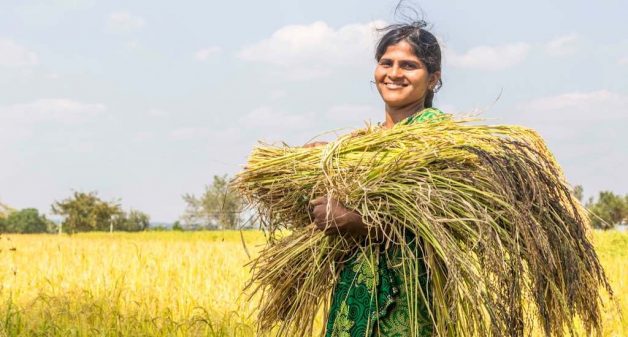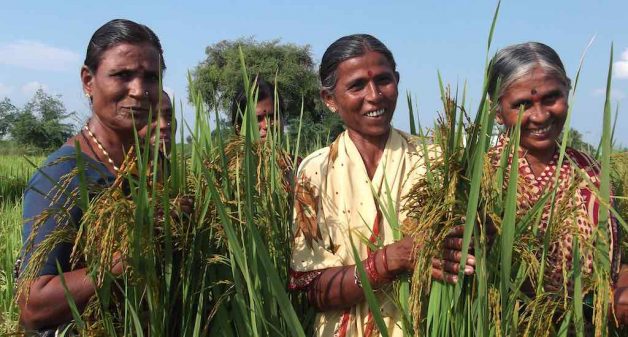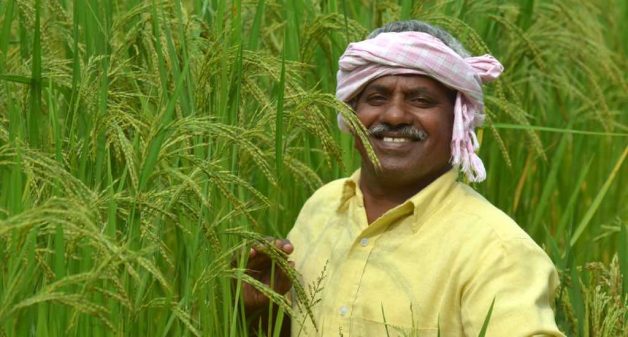
Farmers across India revive folk rice varieties
Cultivation of traditional rice varieties is becoming popular in Chhattisgarh, after a campaign to popularize indigenous paddy strains spreads from Kerala to Himachal Pradesh to West Bengal

Cultivation of traditional rice varieties is becoming popular in Chhattisgarh, after a campaign to popularize indigenous paddy strains spreads from Kerala to Himachal Pradesh to West Bengal
Sukhbuddhi, a resident of Golawand village in Chhattisgarh’s Kondagaon district, is one of the many farmers safeguarding traditional rice varieties against the prevalence of high-yielding ones. In this, she is inspired by seed campaigner Shivnath Yadav, whose Dharohar Samiti organization has till date conserved 307 varieties of indigenous paddy since 1995.
At the village seed center, Yadav displays his carefully preserved paddy seeds with ears wrapped in white paper to protect them from moisture. In one of the rooms, a big basket made of straw and ropes, locally called dhhusi, rests on a table. It is a reminder of traditional seed conservation practiced by our forefathers. About 150 organic farmers in the district, who work with Yadav, swear by the basa bhog and lokti machhi rice varieties in this rain-fed region.
India’s indigenous or folk rice varieties, which had passed into oblivion due to the market dominance of high-yielding varieties and the prevalence of the basmati in terms of aroma and taste, are making a comeback to many farms and plates, thanks to the efforts of revivalists and rice enthusiasts like Yadav.
Rice revival
The revival effort dates back to the early 2000s. The Save Our Rice campaign, which started in Kumbalangi (Kerala) in 2004, helped promote traditional paddy varieties in Karnataka, Kerala and Tamil Nadu. It later spread to Chhattisgarh and West Bengal.
Sreedevi Lakshmikutty, based in Coimbatore in Tamil Nadu, was one of the participants of the 14-year-long campaign. According to her, a great need was felt to save the indigenous varieties, which disappeared from farmers’ fields with the advent of the Green Revolution, and the central government’s procurement and distribution processes under the public distribution system. The campaign successfully revived the mullan kazhama rice of Kerala, a scented variety.
“Those who stopped growing it took up its cultivation again. Many farmers had retained its memory and recalled that their forefathers grew it in farms. Through our campaign, we conserved some 1,000 rice varieties. Initially, the farmers would try out the traditional varieties only on small patches of land,” Lakshmikutty told VillageSquare.in. “To promote folk or indigenous rice varieties, we organized food melas.” As part of the campaign, Kerala revived 240 varieties, Tamil Nadu 160 and Chhattisgarh 400 varieties.
Misconceptions on yield
However, Lakshmikutty rues that the trade volume of folk rice is still low in the market. Perhaps it has something to do with the misconception that indigenous varieties are characterized by low yields.
An article published in Farmers’ Forum (Vol. 16; No. 1, February-March 2016) magazine by Anupam Paul, assistant director of agriculture, Government Training Centre at Phulia in West Bengal, says, “The fundamental question is whether FRVs (folk rice varieties) are low yielders. There should have been comparative yield studies between folk rice and modern varieties in the same land situation, which are conspicuous in their sparsity. There were comparisons of grain yield but not of the total productivity of the rice fields and the collateral advantages of growing the folk varieties.”

Paul asserts that the yield of folk rice is not less than the high-yielding varieties in some locations, and there is government data to prove it. There are other advantages aw well. The folk varieties do not need fertilizers and pesticides to grow, and there is no need to replace the seeds every year. The article further explains that many FRVs are suitable for marginal land and compete with modern varieties with low cultivation cost and minimum organic inputs.
Akash Badave, chief executive officer of Bhoomgadi Organic Farmers’ Producer Company Ltd, a farmer producer company based in Dantewada in Chhattisgarh, agrees. He points out that the indigenous varieties are better adapted to specific agro-climatic zones, more resistant to erratic weather and pests and diseases, and have high nutritional value.
“Our failure to recognize their importance was the reason that they were majorly neglected in the mainstream. But many farmers preserved the seeds and that is how they are being revived,” Badave told VillageSquare.in. According to research associate Ullasa M.Y. from the University of Agricultural and Horticultural Sciences, Shivamogga, Karnataka, traditional paddy varieties are suitable for organic farming conditions.
In Shivamogga, the conservation movement started in 2008. Till now, 223 indigenous varieties have been revived. The rajamudi rice has come back in a big way.
Spreading market linkages
A sure way to spread awareness about these unsung treasures among food connoisseurs is to tickle the taste buds through a wide array of tempting rice-based dishes. Abhishek Basu, executive chef at The Park hotel in New Delhi did just that. Basu presented mouth-watering recipes as part of the month-long Rice Up festival, which was organized a few months ago.
Building bridges
The rice festival was part of The Park hotel’s attempt to provide a platform to farmers cultivating traditional rice varieties, and thus create a bridge between food growers and consumers. The Delhi Organic Farmers’ Market (DOFM), which is hosted every Sunday at the hotel, is another successful way to connect farmers and customers and ensure that the former gets the right price for their produce.
Ashish Gupta, one of the four trustees of DOFM, points out that the marketing always happens in the name of farmers, even though they may not be physically present.
DOFM works on two basic principles. The farmers retain the right to decide the prices of their products after taking into account production cost and prevailing market conditions. Thus, they get a chance to maximize their profits.
Then there is the retail store, Jaivik Haat, a part of DOFM, which provides a ready platform for showcasing farmers’ produce. In case farmers are unable to decide suitable prices of their products, Jaivik Haat returns 60-70% of the final market value to farmers’ accounts.
Strengthening farmers
Besides the right kind of marketing, strengthening farmers is also the motto. Bhoomgaadi promotes 100 varieties of indigenous paddy among 1,700 local tribal farmers, who are its shareholders. Badave explains that through the center, farmers get better rates, about 5-20% higher than that of the market, and improved linkage. His center stocks the sathi rice, dubraj (a scented paddy variety), khamang and lokti machhi, among others.
The Tirunelli Agri Producers’ Company was formed a year ago to ensure farmers’ fair share, with 50 shareholders. Here, regular red rice is procured at Rs 29 per kg from farmers, said Rajesh Krishnan from Waynad, Kerala, who returned to his roots to grow paddy five years ago. For aromatic varieties, it is Rs 50 per kg.
According to him, growing paddy is a labor-intensive activity and brings together societies, communities and the people. Krishnan says that by growing paddy, one provides employment to locals and invests in the economy.
Rice fairs
Another successful way to promote traditional rice is to sell them through rice melas, or fairs. Shankar Langati from Belgaum sells 26 varieties at a weekly market on Thursday in Dhadwad in Maharashtra and is associated with 46 rice growers. All the varieties are rain-fed and low inputs are needed to grow them.
To attract customers, he has classified them as dosa rice, idli rice and rice for making sweet dishes. There is rice for children too. In this way, food diversity is ensured. Generally on Thursdays, rice worth Rs 35,000 is sold. Medicinal and black rice are sold at Rs 120 per kg, dosa rice at Ra 40 per kg and scented rice at Rs 70 per kg. The group buys rice from farmers at a premium.
Incentives to popularize
Shiva Prasad Raju, based in Hyderabad, offers consultancy services to farmers. According to him, free seed distribution in Andhra Pradesh and Telangana has helped in popularizing the concept of growing folk varieties. Informing customers about the benefits of eating these varieties help in enhancing the sale.

However, despite marketing, some varieties like joha and komal from Assam are still languishing. Joha is a scented, short grain rice, which aids in digestion. It has been limited to Assam only. According to Rama Tiwari, operations head, Northeast, Sri Sri Tattva, an organization that promotes organic products, it takes more time to grow and that may be the reason behind its decline.
Katarni rice cultivated in Bhagalpur, Bihar, is also on the decline even though it has acquired the geographical indication (GI) tag. One of the main reasons behind its declining yield is that the soil turned sandy in the aftermath of floods.
However, some varieties soared in popularity after being recognized under the Protection of Plant Variety and Farmers Right Act, 2001. Horticulture development officer of Chirgaon district in Himachal Pradesh, Kushal Mehta, who has been involved with the revival of chhoharto or peja rice since 2003, said since the patent was acquired, its prices have gone up.
“The rice has medicinal value and is good for pregnant women. It also has protein and iron content,” he told VillageSquare.in. “Before 2003, farmers were not growing it. Now, 1,000 hectares is under cultivation and some 3,000 farmers are cultivating the rice.”
Ancient variety
The kalanamak rice from Uttar Pradesh is a heritage rice from the eastern parts of the state associated with Gautama Buddha. Legend has it that he offered the rice to the people. According to agri-scientist Ram Chaudhary, the total area under kalanamak was 50,000 hectares before the 1960s. Then the high-yielding varieties came in, and became profitable. People lost interest, but some still grew it for family consumption.
The aroma was lost and it was another major reason for its decline. To revive the rice, Choudhary collected 250 accessions of kalanamak. He selected a particular accession and released it in 2007 known as kalanamak 3 or KN3. The area under cultivation went up to 35,000 hectares from 2000 hectares.
“We are now exporting kalanamak. Last year, we exported 20 quintals to Singapore. Farmers are tripling their income. Common paddy costs R17 for 1 kg whereas kalanamak sells at Rs 35-40 per kg. It is now grown in 11 districts of eastern Uttar Pradesh,” Chaudhary told VillageSquare.in.
Issues at large
Although folk rice varieties have caught public fancy, there are major issues that can hinder their production, distribution and sale. Langati rues the fact that there are no community rice processing mills at the local level. At the big mills, there is always a fair chance of the traditional varieties getting mixed with others.
Krishna Prasad of Benagaluru-based non-profit Sahaja Samrudha said as rice from the public distribution system was popularized, each state started subsidizing the rice and it turned into a vote bank. This affected paddy diversity in India. Though the Save Our Rice campaign played a major role in sustaining rice diversity, Sahaja started rice melas in Karnataka to build the right platform for farmers. It also entered into partnership with Nabard, which gave the right market momentum.
Still, Prasad feels, that quality issues are there and no continuous supply. There are also pricing issues, as there is no minimum support price (MSP) declared on traditional rice varieties. Proper nutritional analysis is also necessary. Markets suffer due to the presence of middlemen, as a huge margin after processing goes to them and the millers. Earlier, this was not the case as there was manual pounding.
According to T.N. Prakash Kammareddy, chairman, Karnataka agriculture prices commission, modified MSP should be announced on traditional rice varieties. “We have to come up with an MSP that takes into account their social, cultural, ecological and nutritional aspects as they have different features. Normally MSP considers the cost of production, but in this case there should be more to it than that. Along with MSP, there should be procurement programs.”
Resilient to climate change
Indigenous paddy seeds are more resilient to climate change and grow well in waterlogged areas, said Chakradhar Panda of the Bhubaneswar-based State Seed Testing Laboratory. So, if traditional varieties are not preserved, future food and nutritional security would be at stake. “Some have already vanished. I surveyed 1,250 varieties in Odisha but found only 1,130. I did not find the rest,” Panda told VillageSquare.in.
When it comes to conserving and promoting indigenous seeds, Odisha has met with considerable success. Panda points out that the initiative was started a decade ago when most farmers were still growing indigenous varieties. The agriculture department decided to document local paddy seeds through a statewide survey.
“As a government seed analyst, I have collected indigenous seeds, preserved them and registered them under the Protection of Plant Varieties and Farmers’ Rights Act under the name of the farmer or the group from whom these seeds have been collected,” said Panda.
So far, the revival of folk rice varieties looks promising. It remains to be seen whether these varieties can capture the market in a big way and dominate India’s food scene.
Deepanwita Niyogi is a Delhi-based journalist. Views are personal.